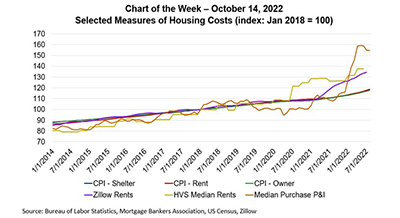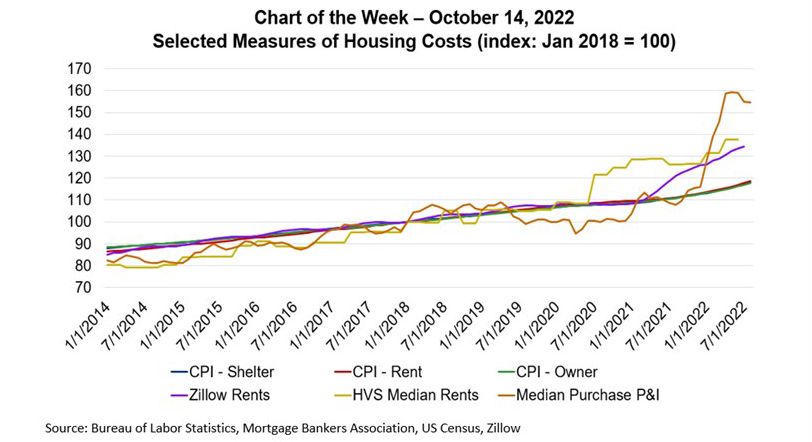
MBA Chart of the Week Oct. 14 2022: Housing Costs

Last week, the U.S. Bureau of Labor Statistics released its September Consumer Price Index. Inflation as measured by the CPI grew by 8.2 percent in September, compared to a year ago. While this reading was lower than its recent peak of 9.1 percent in June , these growth rates are still hovering close to 40-year highs.
Core inflation, excluding food and energy, was running at a 6.6 percent year-over-year rate, a new high since August 1982. Food prices increased by 11.2 percent, and shelter costs were up 6.6 percent over the year, more than double the historical average. Given how persistent this measure of shelter cost inflation tends to be, market participants are monitoring this number closely, and it is good to understand how it compares to other measures of housing costs.

This week’s Chart of the Week highlights different measures of housing costs, all indexed to 2018. The lowest lines are the CPI measures of shelter costs, including the “’all-in” shelter measure and breakouts for rents and owners’ equivalent rents. The CPI rent measure can be considered “in-place rents” since it mainly captures costs to renters currently in their homes. The purple and yellow lines are two measures of asking rents using data from Zillow and the U.S. Census Bureau, showing what an available apartment commands in today’s market. The gold line is from MBA’s Purchase Applications Payment Index (PAPI), a measure tracking monthly mortgage principal and interest payments for the median person applying for a new loan to purchase a single-family home.
As can be seen, increases in interest rates and in asking rents have led to a dispersion of these different measures. While telling very different stories, all measures show the continued pressure housing costs are exerting on overall inflation.
The strong job market and rapid wage growth have also been key factors contributing to elevated inflation. There have been early signs of weakening in the job market, as the number of job openings decreased sharply in August to just over 10 million. However, even with a lower level of job openings, there is still significant upward pressure on wages.
We expect the Federal Reserve will increase rates by 75 basis points in November and 50 basis points December in an attempt to further cool the economy and bring down inflation.
–Mike Fratantoni mfratantoni@mba.org; Joel Kan jkan@mba.org; Jamie Woodwell jwoodwell@mba.org
